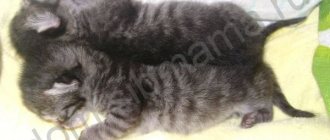Cat birth is the most sensitive and decisive process. The birth of a new life causes excitement among the owners, especially those who are encountering such an important event for the first time. But owners are more frightened by another point: how to understand that a cat has given birth to all the kittens? After all, the birth of each cat takes a certain period of time. The owner who is very worried about the cat needs to prepare in advance and find answers to all his questions.
What signs should you look out for?
When it comes to the fact that a cat may not give birth to all kittens, then this situation poses a danger to the pet, even to the point of death.
A fetus that is not born will eventually begin to decompose in the womb, releasing toxic substances that are harmful to the animal. How to determine if everything is okay and what help to provide to your pet? The birth is not considered complete if:
- the cat after giving birth is not interested in kittens and does not lick them;
- refuses food and water;
- a day later, the cat’s temperature rose to 39 degrees or higher;
- when the fetus appears, the cat does not change position and continues to periodically push;
- the abdomen is hard and tense on palpation, the fetus can be felt;
- after 2 days, urine and feces are colored scarlet, and an unpleasant odor emanates from the pot.
The birth process in a cat occurs in 3 stages. First, the cat begins to moan and meow, the cervix opens, and the birth plug with discharge comes out. In the second phase, contractions become intense, the cat tenses, and kittens begin to emerge through the birth canal.
It happens that a cat runs away in fright or gets lost during the first lambing; in this case, it is important to re-examine the kittens and, if necessary, cut the bladder with sterile scissors so that the cub does not suffocate. At the final stage, the placenta is separated; it is important to ensure that the cat does not eat the afterbirth or the stillborn (weak) kitten
If all the rules are followed, but there are still concerns that the cat has not completely given birth, it is important to contact a veterinarian for help.
At the final stage, the placenta is separated; it is important to ensure that the cat does not eat the afterbirth or the stillborn (weak) kitten. If all the rules are followed, but there are still concerns that the cat has not completely given birth, it is important to contact a veterinarian for help.
Have all the kittens been born?
Of course, when a single kitten is born, such questions do not arise. Of course, there are cases of single births, but they are rare. But let's say your cat has already given birth to three or four kittens. How do I know if they are still in the womb?
Only an ultrasound can answer this question, but there are signs that if you notice them, it is recommended to call your veterinarian or take your cat to the clinic:
- The birth appears complete, but your pet shows little interest in the newborn kittens, meows constantly, runs around the house, and shows other signs of extreme anxiety.
- Remember that in the normal course of labor there is a third stage of labor. This is not “officially” recognized by all veterinarians, because at this time the remains of the placenta and other “garbage” leave the animal. This stage should not be accompanied by cramps and pressure. If a cat that has already been born shakes and experiences strong contractions from time to time, there is clearly no problem. Either there are still kittens in her uterus, or there are signs of some postpartum abnormalities. In any case, it won't hurt you to contact your veterinarian right away.
- It happens that the kitten in the uterus (or several kittens) is already dead and for some reason the contractions are weak when they come out into the light. In such cases, a few days after birth, the cat's condition sharply deteriorates, and a greenish-brown discharge (ichorosis) with a disgusting, suffocating smell of rot appears from the external genitalia. It is easy to understand that even in such a situation an urgent visit to the veterinarian is necessary.
Alarming symptoms
An unqualified owner cannot always help a furry pet. That is why during childbirth you should have the telephone number of the treating veterinarian, or preferably two or three numbers, at hand. Four symptoms are a serious reason to contact a specialist.
Ahead of schedule. Most often, premature birth occurs in a cat due to a frozen pregnancy, non-viability of the offspring, placental abruption, or trauma. The stages of labor pass faster already on the 50-55th day, sometimes earlier. Most often, a cat gives birth to dead kittens. The living premature offspring dies in the coming days. It happens that a cat gives birth to just one dead baby prematurely. The rest emerge alive and healthy on time. If your cat gives birth prematurely, have her examined by a specialist to understand further steps. Lack of childbirth. If the pet does not give birth for more than 70 days and if this is not a false “birth” due to an imaginary pregnancy in the cat, then the pregnancy is probably frozen. The cubs most likely died, so it is urgent to save the pet from possible infections and damage to the uterus. Missed birth
It is important to determine when labor is truly over. If the pushing has stopped and the cat is resting, this does not guarantee that all the kittens will come out.
You should observe your mother's behavior. A cat that has not yet given birth reluctantly takes care of the cubs, does not leave the “nest” and does not change position, refuses to drink, and periodically strains. To make sure, you can feel the stomach three to four hours after birth. The elasticity and tension of the muscles indicate that there is still a kitten left in the womb. Discharge. Any colored, pungent-smelling discharge during pregnancy and childbirth is a deviation from the norm. During strong, long contractions (more than an hour) without subsequent labor, blood may flow profusely. In this case, it is also necessary to show the cat to a specialist.
Fetal pathologies do not always depend on the health of the mother and can be inherited from the father. However, the physical and mental condition of the cat affects the successful outcome of the birth.
Therefore, it is important that the pet is healthy before mating. Unfavorable factors for childbirth are old age, obesity, stress, heredity
Even the process of childbirth in a cat, supported by instincts, does not always go smoothly. You should mentally prepare for any outcome. However, do not panic prematurely and do not intervene without reason. Nervousness will be transferred to the pet, and during childbirth she will be confused. Rest assured that everything will go well and the cat will be able to rely on its owner.
This simple question is asked not only by experienced breeders of the breed, but also by ordinary owners of furry four-legged animals who expect a new addition to the family in the near future. But really, how can you tell if a cat is about to give birth?
? Let's try to figure this out.
What to do if the cat cannot give birth to the “last baby”?
Let us emphasize once again that only a veterinarian can accurately identify the presence of “belated” kittens and only with an ultrasound (or x-ray, at worst). We would not recommend touching and kneading your pet’s belly on your own. So you are unlikely to be able to understand whether the cat gave birth to all the kittens or not, but it is entirely within your power to harm the animal.
So, there is a baby in the womb. For some reason, a cat cannot give birth on its own. What to do? If the animal is not very exhausted by childbirth and the muscles of the abdominal wall and the uterus itself are contracting normally, you can try to stimulate the “second round” of labor by administering oxytocin . In this case, there is a chance that the contractions that have started again will help bring the matter to an end.
But you need to remember that oxytocin is not the safest drug, and therefore when using it you need to take into account important nuances:
- If after administration of the first dose (no more than 5 IU) no signs of contractions are observed, further administration should be considered pointless and even dangerous.
- If the cat's body temperature does not exceed 37.5° Celsius, it is also not worth artificially inducing labor.
- Bradycardia, tachycardia, and other cardiac or respiratory disorders are also contraindications for oxytocin.
Thus, drug stimulation is not used too often, since for this the general condition of the cat must be close to ideal. But this, taking into account some “problems” at birth, does not happen often. In other words, we need some other option. And if the cat did not give birth to the last kitten, this is a cesarean section.
The main signs of the end of labor
When a cat gives birth, it is important to make sure everything is successful in the end. This can be judged by the presence of the following signs:
- As soon as the mother realizes that all the kittens are out, she begins to actively care for the offspring, feeding them milk. At the same time, the cat intensively licks the babies, feeds them, purrs;
- If you listen to your breathing, you will find that it is even. Heart beats and pulse are rhythmic and follow at a normal speed;
- Mom eats and drinks with pleasure;
- the pet is able to get up and walk at least a little;
- when labor ends, if palpation is done no earlier than 40 minutes later, the abdomen will feel soft and relaxed to the touch. When palpating, you cannot feel the presence of seals. The muscles may be tense for a short period of time, but this quickly passes.
An indirect sign of a favorable end of labor may be the natural and calm behavior of the pet. However, it is normal for some cats to remain calm even when giving birth.
How does the feline birth process work?
Cats bear offspring for about 64 days, in rare cases - up to 70 days. On average, there are 3-5 kittens in a litter, but cases of the birth of eight cat cubs have been recorded. The duration of labor is influenced by several factors: age, number of fetuses, number of previous lambings, breed, diet during pregnancy. On average, the process of childbirth in cats takes from several hours to a day and a half, and includes periods of contractions, pushing and expulsion of the fetus.
The cat's first contractions may be invisible to others because they are still weak. At this time, your pet can be busy arranging the nest. As the contractions intensify, the cat may moan, meow, and its body periodically tenses in efforts. Then the cervix opens, the mucous birth plug emerges through the birth canal, followed by the first kitten.
Kittens are born “in order”, usually with a break of half an hour to 12 hours. Their birth may alternate with the expulsion of the placenta, which the cat sometimes eats. Kittens are born in the embryonic membrane (amniotic sac), the cat chews it, licks the cub, then bites the umbilical cord. The mother can begin feeding already born kittens in between contractions.
If your pet ignores the newborn kitten, the owner present at the birth will have to open the amniotic sac himself, carefully wipe the kitten and place it next to the mother. During the birthing process, your cat may need several hours of rest.
It is difficult for an inexperienced cat owner to understand whether all the kittens have already come out, or whether this is a break in childbirth. Even an ultrasound scan performed during pregnancy does not always reliably determine the exact number of fetuses. You can focus on the signs of the end of the birth process
During the birthing process, your cat may need several hours of rest. It is difficult for an inexperienced cat owner to understand whether all the kittens have already come out, or whether this is a break in childbirth. Even an ultrasound scan performed during pregnancy does not always reliably determine the exact number of fetuses. You can focus on the signs of the end of the birth process.
Reasons: why is only one kitten born?
There is no need to worry, as the likelihood of having an only baby, especially in a young cat, is more common than it might seem. The physiological reasons why one kitten may be born are not related to health anomalies, and are most often associated with age or the course of pregnancy in the early stages. However, among the factors associated with singleton pregnancy, shortcomings in animal care often appear.
The main reasons for the birth of one kitten:
This phenomenon can be observed in older females.
- Heredity. Some breeds, for example, Persian cats, are characterized by a minimum number of kittens in the litter. Genetic predisposition also influences the offspring. This happens if several generations in a pet’s family produced only one cub.
- Age. A cat that is too young or old is more likely to give birth to one kitten. The first pregnancy in an animal, as a rule, often ends in the appearance of a single calf.
- Physical state. The formation of kittens largely depends on the resources of the mother’s body. With a lack of vitamins and poor nutrition, a cat may produce a litter only once, and an exhausted animal may not reproduce at all.
- The only egg fertilized during mating.
- Reproductive function of a cat. The health, age and fertility of the partner affect the quality and quantity of semen, and therefore the success of fertilization.
- Intrauterine processes. Not all fertilized eggs attach to the wall of the uterus, and at a later date, resorption of the fetus may occur in the cat.
Signs of the end of labor
After forty minutes, the mother’s belly becomes soft.
The first symptom is active care of the offspring. The animal diligently licks the kittens, purrs, and feeds. The pet breathes evenly, the pulse and heartbeat are stably rhythmic and do not go beyond physiological parameters. After a short time, the cat shows interest in food and drink
The pet can get up from the nest and leaves its brood for a while. After forty minutes, the mother’s abdomen becomes soft; palpation does not reveal any lumps. However, the uterus may remain in good shape for some time, which can be mistaken for a kitten. In this case, you should not squeeze the cat’s stomach too much; you should place both hands on the sides of the animal and carefully move along the ribs. It is recommended to check after the forty-minute period has expired. An additional sign is the cat’s calm behavior, but due to the fact that some mothers behave calmly even during childbirth, this sign is not a 100% guarantee.
How to understand that a cat is giving birth: main signs
On average, pregnancy in cats lasts 65 days (plus or minus 5 days). This period usually guarantees the birth of healthy kittens. But how to know that a cat is giving birth - not every person knows the signs of this event. Many inexperienced owners begin to worry about the upcoming event as soon as they notice that their pet is pregnant. The owner of a cat who is about to give birth for the first time experiences special experiences. And the pet itself often shows anxiety. And I must say: not in vain.
But don't worry too much. You will have enough time to become familiar with the cat's behavior during this period and prepare the necessary supplies for giving birth at home. First, let's try to understand what signs can be used to guess that a cat is pregnant. It will be easiest to recognize an “interesting position” and calculate the date of fertilization if the mating was planned, and you know from what point to keep a record of the pregnancy, which is conventionally divided into three stages with characteristics characteristic of each.
If the fetus is in the birth canal, what to do?
In this case, you can try to stimulate contractions so that the body itself pushes the kitten out. But if this doesn’t help, then you should pull out the stuck kitten yourself.
This process is very complex and requires enormous responsibility, since in your hands is the life of not only the kitten, but also the cat itself.
Wear sterile gloves and disinfect. If you see the kitten's head, check to see if the amniotic sac allows you to insert a finger into the fetus's mouth. If everything works out, turn the kitten's head in the right direction; contractions at this moment will help push him. Gently pull the kitten out. If the fetus is lying on its sacrum, pull the legs carefully.
If the fetus is dead, then you can no longer resort to being careful and pull the fetus by any part of the body, the main thing is to help the cat give birth to everyone. The natural process will help you give birth.
Helping a cat push out a kitten is dangerous. After all, this threatens the baby. The cat itself knows what it is doing, nature helps it bear it.
How to prepare a cat for childbirth?
In the last week of pregnancy, it is recommended to protect the cat from stress as much as possible. The expectant mother's bed, tray and bowls must be moved to the most remote and quiet room
It is important that there are no drafts in the room and a constant temperature regime is maintained.
1-2 weeks before giving birth, most cats begin what is called nesting. The pet is looking for a secluded, dark, quiet and warm place in which she will give birth and raise kittens.
In most cases, cats prefer to make a nest in closets or under the bed. The expectant mother, who has free access to the street, is likely to build a nest outside the house, for example, under a threshold or in an improvised hole.
Note that giving birth to kittens in a closet is convenient for the cat, but not for the owner. Monitoring the growth and development of kittens involves regular weighing. Temperamental and primiparous cats may become protective of their offspring, making kittens difficult to obtain. By arranging a nest for a cat and her future offspring in advance, you will eliminate a number of problems in the first month of the kittens’ life.
As a nest, you can use special boxes that are sold in a pet store or a regular, durable cardboard box. Experience shows that cats prefer to build their nests in a closed box with a roof. The side of the box is cut so that the cat can easily step over the threshold without clinging to its stomach.
During the birth process, the bedding in the box will be wet, so it is recommended to stock up on moisture-absorbing diapers. For the first 4–5 days after birth, until the babies' umbilical cords fall off, it is recommended to use only white cotton fabric as bedding. On white bedding, you will immediately notice dirt or suspicious discharge from your cat.
In addition to arranging the nest, you need to take care of preparing an emergency first aid kit. If the birth occurs without complications, your intervention will not be required.
In case of difficult labor and the need to open the amniotic sac, you will need several pairs of sterile surgical gloves. If the cat refuses to lick the kittens, amniotic fluid must be removed from their respiratory tract, and for this it is convenient to use a baby syringe or a syringe with a soft tube.
For any complications during the birth process, it is recommended to contact a veterinarian. Arrange in advance with your doctor about telephone consultations and home visits, if necessary.
In rare cases, the umbilical cord vessels do not close, so they have to be ligated. You can use strong cotton, nylon or dental floss as a dressing.
Use sharp, sterile scissors to cut the umbilical cord. Pour boiling water over the scissors in advance or treat them with alcohol, then place them in a clean bag and do not take them out until delivery.
In addition to moisture-absorbing diapers, which are used as bedding, you need to stock up on a large number of cotton pieces to wipe and wrap the kittens.
Just in case, prepare several terry towels that retain temperature well. In case of complications, you will have to remove the kittens from the nest, so a spare box of bedding and a heating pad will be useful.
After the first or difficult birth, some cats refuse kittens, that is, they ignore and do not feed them. To take control of the situation, buy several packets of milk replacer and a kitten feeding bottle in advance.
Helping an animal during an unfinished birth
Only a doctor can diagnose a failed fetus and help your cat. But there are rare cases when there is no doctor nearby and you cannot get there yourself.
Then oxytocin, which is sold in ampoules for intravenous administration, can come to the rescue. It will help stimulate another birth, contractions will begin, the uterus will begin to contract and throw out all the remaining babies.
The dosage of this drug is 0.3 IU/ml and you only need to administer this dose, no more! If this dosage does not help, there is no need to administer another ampoule, this will only make things worse.
Keep in mind that oxytocin has a number of contraindications, such as: disorders of the cardiac and respiratory systems, tachycardia, temperature above 37 degrees. There is no need to introduce it if the fetus is lying incorrectly or the cat’s size is non-standard.
It is extremely dangerous to resort to this kind of behavior, so you should not do it immediately as soon as you sense something is wrong. Childbirth is a natural process for cats too. Her instincts guide her and she does her best. Perhaps the cat needs time and she controls the birth process herself. Therefore, wait, watch the kittens being born and watch the reaction of your pet. In 99% of cases, cats give birth without any problems.
Another type of help on your part is support and affection. Always stay close to your tailed one, support her mentally at this important moment, caress her and say pleasant words. The cat feels everything and childbirth will not be so scary for her.
The support of a loving owner really helps the tailed cat give birth much calmer.











